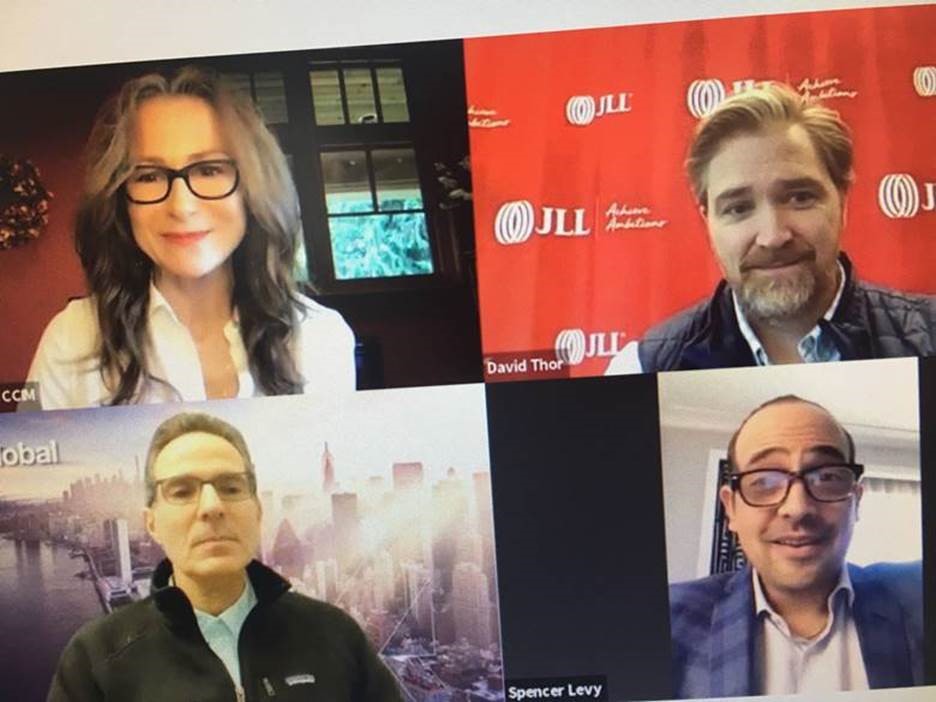Thought Leader Takeaways: NAI Global President & CEO Jay Olshonsky’s Panel Participation on the CCIM Webinar – Rethinking the New CRE Landscape
On October 19 and as part of CCIM’s 2021 Global Conference, NAI Global President & CEO Jay Olshonsky, CCIM, FRICS, SIOR, (pictured lower left) was one of three panelists on the thought-provoking webinar, Rethinking the New CRE Landscape. In the one-hour segment, the panel discussed the pandemics impact on the commercial real estate industry and some of the trends and storylines to expect in the near future.

The webinar was moderated by Lydia Bennett, CCIM, CPM, President Commercial Real Estate West Coast (based in a Seattle suburb, she is also a CCIM Instructor). In addition to Mr. Olshonsky, Spencer Levy, Global Chief Client Officer and Senior Economic Advisor with CBRE and David Thor, CCIM, SIOR and Executive Vice President with JLL (based in Pittsburgh, PA) were the other panelists.
Ms. Bennett got the discussion going by asking the panel about the swinging pendulum of the office market and Mr. Levy pointed out that what has happened with office real estate and remote work “is not a real estate issue, it’s a labor issue.” He added that the pandemic shifted power from management to labor while Mr. Olshonsky said that remote work only affected approximately 50% of America’s workforce, with fast-casual restaurant workers and warehouse employees going to work daily during the pandemic. He added that “we could not have done this (remote work) 10 years ago without the technology that exists today.”
Mr. Thor, who does a lot of site selection work with a JLL team around the U.S., made an interesting observation in that he isn’t seeing companies based in urban environments moving to the suburbs, as some people expected would happen. He said that the corporate services work his group does with businesses in the suburbs were suburban-based businesses to begin with.
On the overall health of commercial real estate, Mr. Olshonsky said that there “is no question that things are getting better for all property sector types,” and that he was hearing from NAI Offices in the Far East that they are back to pre-pandemic activity in their respective markets.
On the industrial market, to begin with Ms. Bennett called industrial the clear winner by property type from Covid-19 – a common theme in just about every conversation or story on the industrial market. Mr. Thor reported that there have been some conversions of office buildings to industrial facilities, particularly near metro areas and by ‘last mile’ operators, while Mr. Olshonsky cited a Prologis executive who exclaimed in a recent article that “industrial is fully leased.”
Mr. Levy described what we he called a “prevailing theory” that the global supply chain would or could shift to a series of regional supply chains, or a “+ 1 world” in which, for example, China + Vietnam or China plus another nearby Asian country could be one of many global supply chains yet not his favorite one that he called the Big MAC – Mexico, America and Canada. He also noted that there is some frothiness in the industrial market but it is not the Amazons or Walmarts causing it; rather, it involves fringe and secondary markets with industrial buildings trading in the 3s (Cap Rates). And something to look for as it relates to demand for industrial buildings – if ecommerce penetration slows considerable or even declines moderately, it could create an imbalance on supply and demand for this product type.
The webinar also touched on retail real estate, inflation’s impact on the commercial real estate industry, investment returns, land markets and the surging demand in single-family rental housing, including the latter being a potential alternative play for investors and developers in lieu of competing to buying existing multifamily assets at extremely low rates of returns.
To listen to the entire CCIM webinar, please click here: Rethinking the New CRE Landscape – YouTube (Courtesy of the CCIM Institute).